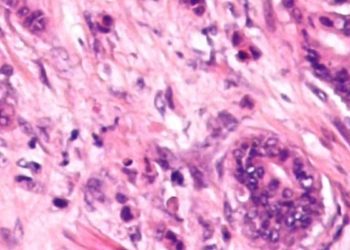No differences in pain between suture and staple C-Section closure
1. There were no differences in pain scores immediately and 6 weeks post-operatively between women with staples compared to suture closure after cesarean delivery.
Evidence Rating Level: 1 (Excellent)
Study Rundown: As many as 1.3 million women in the United States undergo C-sections annually, accounting for nearly one in three deliveries. In a cesarean delivery, a 4- to 6-inch low transverse, Pfannenstiel incision is made horizontally just above the pubic symphysis. At the end of the delivery this incision is closed with either continuous absorbable suture or staples that must be removed at a later date. Available guidance regarding best practice for skin closure is limited and closure type is often determined by physician preference. Previous investigations have demonstrated that staple closure is faster and less labor intensive for the physician. A strong body of evidence, including a recent randomized controlled trial from this research group, demonstrated decreased wound complication rates with suture compared to staple closure. In this study, researchers performed a secondary analysis using this same dataset to look at differences in patient pain perception between the 2 closure types.
There was no difference in patient-reported pain scores or pain medication use between women closed with staples compared to sutures. These findings contradict those of a much smaller trial which identified higher pain scores with staple closure. Strengths included large, diverse sample size, multicenter design and assessment of pain medication across an extended 6-week period. Limitations included verbal pain score from 1 to 10 as opposed to the more well studied visual analogue score and a high loss-to-follow up rate for postpartum pain assessment (21 percent for each group) such that non-random attrition may contribute to selection bias. Future investigations might assess pain scores by phone assessment or via email to achieve higher follow-up rates.
Click to read the study in Obstetrics & Gynecology
Relevant Reading: Suture compared with staple skin closure after cesarean delivery
In-Depth [randomized controlled trial]: Researchers conducted a secondary analysis of a multicenter trial that randomized women to suture (n = 370) or staple (n = 376) closure of a low transverse skin incision at the time of cesarean delivery. Prespecified secondary outcomes included patient-reported pain (from 1 to 10) and pain medication use both during hospitalization and 6 weeks postpartum.
Patient-reported pain scores were similar between staple and suture closure during hospitalization (3.9 vs. 3.9, p > 0.05) and at 4-8 weeks postpartum (1 vs. 1, p > 0.05). Total pain medication use was also similar between groups both during hospitalization (56mg intravenous morphine for suture vs. 54mg for staples, p > 0.05) and at 4-8 weeks postpartum.
Image: PD
©2015 2 Minute Medicine, Inc. All rights reserved. No works may be reproduced without expressed written consent from 2 Minute Medicine, Inc. Inquire about licensing here. No article should be construed as medical advice and is not intended as such by the authors or by 2 Minute Medicine, Inc.







